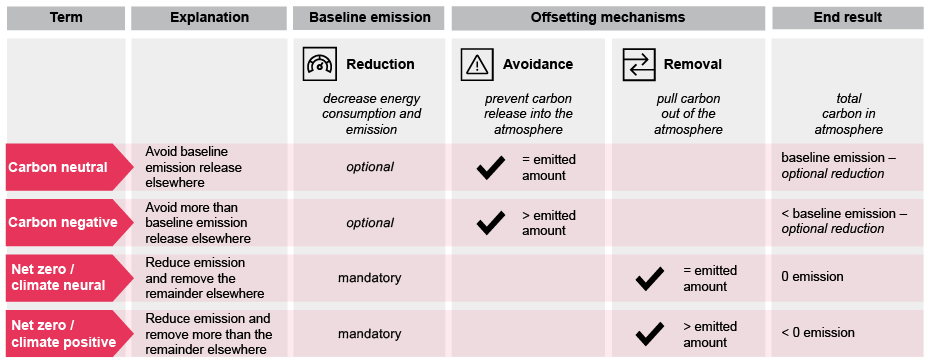To avoid the catastrophic impacts of climate change, greenhouse gas emissions must halve by 2030 – and drop to net-zero by 2050. Consequently, the corporate world is increasingly taking responsibility for climate action. Today, over 2,000 companies are working with Science Based Targets initiative (SBTi) to reduce their emissions in line with climate science.
However, in many industries it is difficult to reduce emission by 100% in the short term. Carbon offsetting can play an important role to accelerate decarbonization by bridging the gap to net-zero in the meantime. In this article, we explain the options businesses have to reach their targets. We start by taking a closer look at the definition of carbon-neutral, carbon-negative, net-zero, and net-negative.
What exactly are companies committing to?
The terminology reflects the type of commitment and the ambition level of companies currently participating in the voluntary carbon market. Whereas the terminology might seem ambiguous at first, the different terms can easily be explained by three aspects.

Firstly, there is a company’s commitment to the reduction of baseline emission, which is mandatory to claim a net-zero and net-negative status, and optional in becoming carbon-neutral or carbon-negative. Secondly, a company can offset the remaining emission. Carbon offsetting can be achieved by two mechanisms:
- Avoidance: prevent carbon release into the atmosphere – well known examples are forest protection or efficient cookstove distribution
- Removal: pull carbon out of the atmosphere – common methods are afforestation and Direct Air Capture and Carbon Storage (DACCS)
To meet net-zero or net-negative goals, offsetting needs to be done solely with removal technologies, whereas avoidance technologies can be used to become carbon-neutral or carbon-negative. Thirdly, the end result determines whether neutrality or negativity can be claimed. The offsetting efforts either cover a company’s total emission or exceed the total emission, in which case a company can claim to be carbon- or net-negative.
Why do companies need carbon offsetting and how do they approach it?
Our experience has shown that companies find it challenging to reduce their emission by 100%. Therefore, carbon offsetting can play an important role to accelerate decarbonization by bridging the gap to net-zero in the short term. Typically, we see 3 different carbon offsetting approaches companies use to reach their target:
- 100% reduction, 0% offsetting: In this approach, the focus lies on emission reduction, thereby eliminating the need for offsetting. This option typically includes actions such as a fundamental redesign of business processes or running joint innovation programs with industry partners
- Offsetting to close the gap: Here the focus is primarily placed on the reduction of emissions and offsetting the remaining emission to bridge the gap. This often consists of efforts in multiple areas to reduce direct emission, involve suppliers to reduce indirect emission, and buy offsetting credits for the remaining share
- Offsetting as focus area: In the third approach, the focus lies on stimulating the development of the offsetting market in general by using corporate offsetting programs. These efforts generally center around the set-up of investment funds, mobilizing finance as well as funding R&D projects
What implications for strategies can be derived from current market developments?
By and large, the dynamic and complex nature of the voluntary carbon market poses several challenges for corporate offsetting strategies. Thus, evaluating those market developments is key to ensuring a high-quality execution of corporate offsetting strategies.

How to get started?
There are many choices to make in designing your corporate offsetting approach. Key steps in designing your corporate offsetting strategy are as follows:
- Take stock and determine where you stand today and where do you want to be
- Define your strategy and decide which route you take to get there
- Design your approach and evaluate what needs to be done to make it happen
Given the urgency of the climate crisis, the important role of carbon offsetting, and the challenges posed by the voluntary carbon market, now is the time for corporate action. Rethink your corporate climate strategy and make it an integral part of your business to take responsibility and remain relevant in the market. With our broad expertise, we at Strategy& can support you in navigating through the complex landscape and design a successful and credible corporate offsetting strategy.
Contact us




